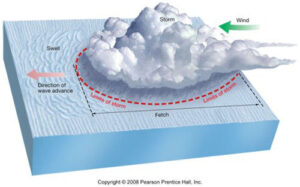Long-period swells are closely tied to the strength and distance of winds over the open ocean. The energy from these swells, located just beneath the sea surface, generates larger waves as they reach shallow coastal waters compared to smaller breakers.

Distinguishing Swells from Tidal Waves
While the effects of Thursday’s swells may resemble a mini tidal wave, they differ significantly. Tidal waves are not wind-generated; they result from a sudden vertical displacement on the sea floor.
Unlike swells, tidal waves’ energy is deep below the sea surface, making them potentially inconspicuous at sea but impactful when reaching the coast.
Although the extremely long fetch has diminished, a local storm approaching the Pacific coast is expected to create a significant swell, albeit potentially not as extreme as Thursday’s event. Large breakers, known as sneaker waves, may develop and pose risks with minimal warning.
Experts advise against coastal activities due to life-threatening conditions, including pounding surf, powerful rip currents, coastal flooding, beach erosion, and potential structural damage. Small craft are urged to stay in port, and inexperienced individuals should avoid venturing into the surf.
Looking Ahead
While large swells and powerful breakers will subside from Sunday afternoon to New Year’s Day, experts caution that the Northern Pacific’s stormy conditions may lead to more rounds of significant surf in the coming months.


